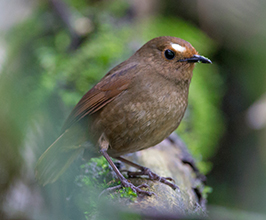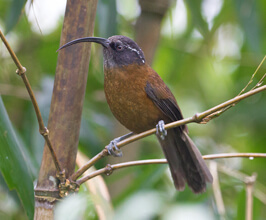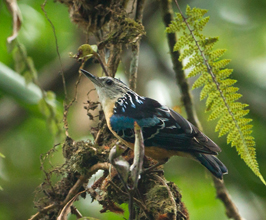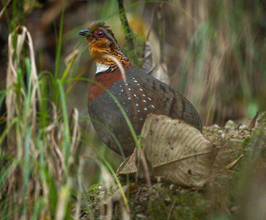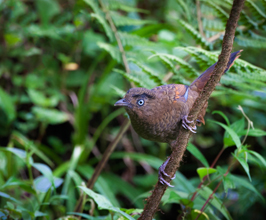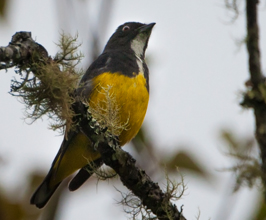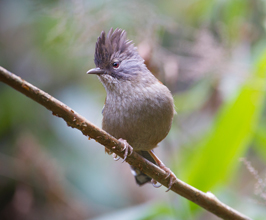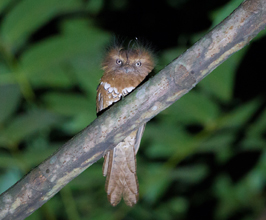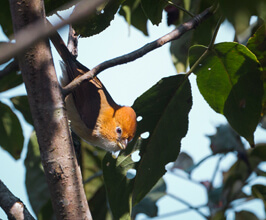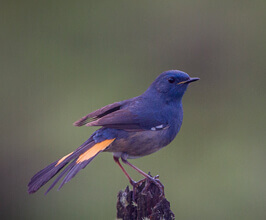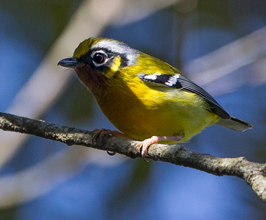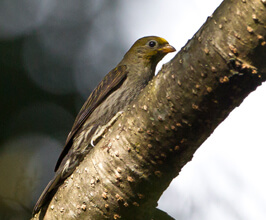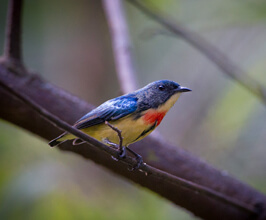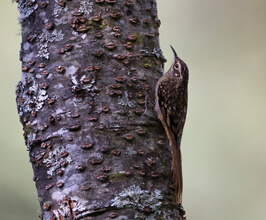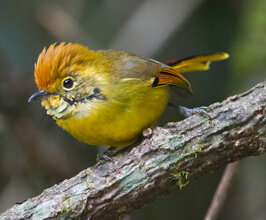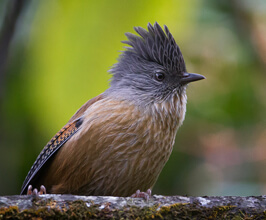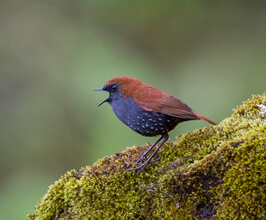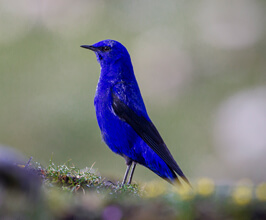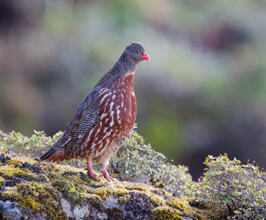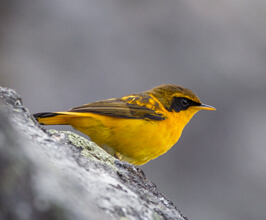Delhi – Guwahati – Nameri National Park - Lama Camp – Bompu Camp - Sessni Camp - Khellong - Eaglenest Pass - Dirang – Sangti Valley - Sela Pass - Mandala Top - Guwahati
14 Days / 13 Nights
Eaglenest is the centrepiece of our Northeast India birding tours. As a birdwatching destination, its specialty lies in its remoteness, its altitudinal range, its immense biodiversity, and the many rare and unique bird species it hosts.
Booked as per
request.
Included except arrival and departure city.

Private guide for complete tour.
Airport to Airport.
2-8PAX
Included
Eaglenest is the centrepiece of our Northeast India birding tours. As a birdwatching destination, its specialty lies in its remoteness, its altitudinal range, its immense biodiversity, and the many rare and unique bird species it hosts.
Spread out over an area of 218 square kilometres in the Himalayan foothills of Arunachal Pradesh, the Eaglenest Wildlife Sanctuary is like nature’s gift to birdwatchers. Rarely does one come across a birding hotspot with altitudes varying from 500 meters to 3250 meters and hundreds of bird species thriving in the thick canopy of forests across these heights. The lower altitudes are blanketed with tropical evergreen forests that give way to temperate broadleaf and conifer forests at middle altitude and alpine woods at higher elevation.
Our Eaglenest Birding Tour covers this entire gamut and goes still higher to the altitude upward of 4000 meters at Sela mountain pass to seek out the birds one sees rarely in a lifetime. Among the most sought-after avian beauties is, of course, Bugun Liocichla, a relatively new find that has put Eaglenest in the ranks of the world’s best birding hotspots.
The itinerary of our Eaglenest birdwatching trip is spread out over two weeks, with each day being either a full birding day or a half one. A India Short Birding Tours of Delhi in India’s capital at the very start primes you up for the long tour ahead. The birding expedition then shifts thousands of kilometres to India’s northeast, a region full of sanctuaries, national parks and reserves.
Nameri National Park on Assam’s border with Arunachal Pradesh is the first pit-stop in our Himalayan birding adventure. The park is home to about 375 avian species, including White-winged duck, the state bird of Assam.
Moving northwards, we enter Eaglenest Wildlife Sanctuary at Lama Camp and head further up to Bompu Camp, located at the altitude of 1950 meters. This camp, consisting of tented accommodation, is our base for several days of birding at Eaglenest. From here, we explore the mid-altitude forests at Sessni camp and we go still lower down to Khellong village.
Our bird targets include Himalayan Cutia, Brown Parrotbill, Red-billed Scimitar Babbler, Coral-billed Scimitar Babbler, Blue-winged Laughingthrush, Rufous-throated Wren Babbler, Maroon-backed Accentor, Hill Partridge, Rufous-throated Partridge, Chestnut-breasted Partridge, Blyth's Tragopan, Temminck's Tragopan, Eurasian Woodcock, Wood Snipe, Jerdon's Baza, Crested Goshawk, Besra, Eurasian Sparrowhawk, Northern Goshawk, Black Eagle, Rufous-bellied Eagle, Mountain Hawk Eagle, Blue-naped Pitta, Silver-breasted Broadbill, Long-tailed Broadbill, Golden-fronted Leafbird, Orange-bellied Leafbird, Collared Treepie, Spotted Nutcracker, Slender-billed Oriole, Maroon Oriole, Black-winged Cuckooshrike, Grey-chinned Minivet, Sikkim Wedge-billed Babbler, Rufous-throated Hornbill, Grey Peacock Pheasant, Chestnut-breasted Partridge, Beautiful Nuthatch, Blyth's Kingfisher, Eyebrowed Wren Babbler, White-hooded Babbler, several species of Shortwings, Rufous-vented Laughingthrush, and Red-faced Liocichla, apart from many others.
The checklist of Eaglenest birds is quite long, and to mark off several exotic and rare species we head westward to the town of Dirang. Keeping it as our base, we explore the high-altitude birding trails at Sela Pass (4160m) and Mandala Top (3000m), looking for avian specialties such as Snow Partridge, Himalayan Monal, Blood Pheasant, Grandala, Rare Gould's Shortwing, Solitary Snipe, Upland Buzzard, White-browed Rosefinch, Plain Mountain Finches, Eurasian Sparrowhawk, Red-billed Chough, Snow Pigeon, Alpine Accentors, Little Owl, Red-fronted Rosefinch, White-browed Tit-warbler, Himalayan Buzzard, Blanford's Rose Finch, Brown bush Warbler, Gould's Shortwing, Naumann's Thrush, Red-throated Thrush, Black-throated/Plain-backed Thrush, White-bellied Redstart, Beautiful Sibias, Fire-capped Tit, Blue-fronted Robin, Spotted Nutcracker, Blue-capped Rock Thrush, and Ward's Trogon.
Over a period of 14 days, we cover the best birding trails of Eaglenest while scouring the forests, the mountain passes of Eaglenest and Sela, the Sangti Valley, Sessa Orchid Sanctuary, and even the lowland woods of Assam. On several occasions, we camp out in tents or birding lodges, we drive past scenic locations with stunning views of the majestic Himalayas, and we even have encounters with wildlife to turn our Eaglenest birding expedition into a sort of Himalayan adventure holiday.
Lodging: The remoter the birding location, the more limited the accommodation options. Since most of our Eaglenest Birdwatching Tour unravels in far-off birding sites, you get to stay for many days in tents with cots and comfy bedding. Lama Camp and Bompu Camp have common toilet. Premium accommodation is available only in Delhi and Dirang during the course of our tour. For three nights, you stay at a birding lodge in Mandala. Rest assured that the tents and lodges only add to your Northeast India birding adventure.
Meals: Meals vary according to accommodation. On the nights we stay in camps and lodges, our expert kitchen staff cooks delicious meals, both vegetarian and meat-based. Since cooking ingredients are limited in these far-flung areas, we depend solely on our stock, which does have enough variety to keep your belly satisfied for several days. On all occasions, our kitchen staff follows hygienic cooking practices. More meal options are available during our stay at Delhi, Nameri and Dirang.
Tour Difficulty: All the birding locations of our Eaglenest birdwatching trip are accessible by motorable road. We traverse a mountainous terrain and do bird-walks at altitudes as high as 4160 meters and spend nights in a lodge at 3000 meters. You should be physically fit and strong to be able to withstand high-altitude conditions. The birding trails may require uphill or downhill slog, or simply long hours of walking with your birding equipment such as binoculars, camera, field guide and backpack. Given the rigours, we accept only birders aged between 15 and 65 for this tour.
Tour Extension: Northeast India holds out several other tourist attractions. The region has many Buddhist monasteries with their ancient relics, colourful paintings, sculptures, quaint architecture, religious rituals and customs. You may want a culture trip to these intriguing temples of worship. Or you may want a wildlife safari in Kaziranga National Park or a leisure trip to the rock music capital of India, Shillong, in Meghalaya. Whatever the tour extension you wish for, just let us know well in advance so that we can make necessary arrangements to extend the Eaglenest birding expedition as per your liking.
Climate: The best time to do our Eaglenest birdwatching tour is from October to mid-May. This is winter and spring season in the region and the weather is cold at high elevations of Sela Pass, Mandala Top, Eaglenest Pass and even Bompu Camp. For these locations, you must carry enough change of winterwear. The weather is somewhat warmer and pleasant at lower heights and summer clothes are suited for the spring season. Do carry a quality raincoat as well for an odd shower or two.
India’s capital Delhi is where our birding adventure begins. Our representative receives you at the airport or railway station in Delhi and drives you to a pre-booked hotel. After a short rest break, we take you out for a birding tour of Delhi.
A metropolis like Delhi may not come across as a birding destination at first glance, but the Okhla Bird Sanctuary, located at Okhla barrage on the outskirts of the city, quickly puts paid to such notions. As many as 300 bird species have been spotted here and our targets for the day include Eurasian Collared-Dove, Laughing Dove, Yellow-footed Green-Pigeon, Greater Coucal, Asian Koel, Grey-headed Swamphen, White-breasted Waterhen, Black-winged Stilt, Red-wattled Lapwing, Pheasant-tailed Jacana, Temminck's Stint, Wood Sandpiper, Whiskered Tern, Oriental Darter, Great Cormorant, Indian Cormorant, Grey Heron, Cattle Egret, Indian Pond-Heron, Black-headed Ibis, Black Kite, Spotted Owlet, Indian Grey Hornbill, Common Kingfisher, Green Bee-eater, Brown-headed Barbet, Rose-ringed Parakeet, Black Drongo, Long-tailed Shrike, Ashy Prinia, Plain Prinia, Sykes's Warbler, Clamorous Reed Warbler, Plain Martin, Red-whiskered Bulbul, Indian White-eye, Striated Babbler, Rosy Starling, Bank Myna, India Robin, Oriental Magpie-Robin, Bluethroat, Pied Bushchat, Citrine Wagtail, Paddyfield Pipit, and Red-headed Bunting.
In the evening we return to our hotel for dinner and overnight. We sleep early because we have an early start the day after.
After an early breakfast, we drop you at Delhi airport for a flight to Guwahati in Assam. The 3-hour flight takes you into the heart of Northeast India. Our tour guide or representative meets you at Guwahati airport and takes you straightaway for a India Short Birding Tours of Guwahati. Though a bustling town, Guwahati still has a few places on its outskirts where one may see an interesting variety of birds. Our target for this short tour is Greater Adjutant Stork.
Freshened by this birding stint, we hit the highway for a 5-hour cab ride to Nameri National Park. We have our lunch at a roadside restaurant and arrive at our destination by evening, with a few hours to spare for some local birding.
Nameri National Park is situated in the foothills of the Himalayas, on Assam’s border with Arunachal Pradesh. It lies just below the sprawling Pakhui Wildlife Sanctuary of Arunachal Pradesh and this geographic bounty makes Nameri a thriving habitat of birds of Northeast India. It is also a tiger reserve with a lot of other wildlife such as leopard, elephant, hog deer, sambar, gaur and Indian giant squirrel. Our evening excursion is a short one after which we retire for the night to our resort in Nameri.
Nameri National Park is accessed by ferrying across the river Jia-Bhoroli, which flows along the southern boundary of the park. Crossing the river, one enters a biodiversity hotspot of semi-evergreen deciduous forests, bamboo brakes, and sporadic grasslands, which are home to a variety of flora and fauna, including 375 species of birds.
Quite early in the morning, we take a boat to cross the river and enter the park. We do birding walks on a selected stretch of the park and look for the likes of White-winged Duck (state bird of Assam), Blyth’s Kingfisher, Great Thick-knee, Wreathed Hornbill, Red-breasted Parakeet, White-capped River-chat, Long-billed Plover, Blue-naped Pitta, Wreathed hornbill, White-cheeked Partridge, Lineated and Blue-throated Barbets, Pin-tailed, Ashy-headed Green and Green Imperial Pigeons, Pied Flycatcher-Shrike, Yellow-browed, Greenish and Grey-hooded Warblers, Oriental Hobby, Pied Falconet, Pallas’s Fish-Eagle, Black Baza, Peregrine Falcon and Ibisbill.
Early morning birding at Nameri National Park is usually rewarding and we return to our resort for breakfast, after which we drive for about 4 hours to a place called Lama Camp. On the way, we stop by Sessa Orchid Sanctuary for a India Short Birding Tours. We arrive at our destination Lama Camp in the evening. Dinner and overnight at Lama Camp.
Lama Camp is the entry point to Eaglenest Wildlife Sanctuary. Since the sanctuary is spread over an area of 218 square kilometres, there is much to explore.
We set off right after the morning coffee to scan the forest around Lama Camp. Our main target for the day is the rare and critically endangered Bugun Liocichla, a small babbler whose discovery in 1995 and re-sighting in 2006 brought much fame to Eaglenest Wildlife Sanctuary as a birding destination. Apart from this little beauty, our targets for morning birding at Lama Camp include Himalayan Cutia, Brown Parrotbill, Red-billed Scimitar Babbler, Coral-billed Scimitar Babbler, Blue-winged Laughingthrush, Rufous-throated Wren Babbler, Maroon-backed Accentor, Hill Partridge, Rufous-throated Partridge, Chestnut-breasted Partridge, Blyth's Tragopan, Temminck's Tragopan, Yellow-rumped Honeyguide, Rufous Woodpecker, Pale-headed Woodpecker, Bay Woodpecker, Rufous-bellied Woodpecker, Crimson-breasted Woodpecker, Darjeeling Woodpecker, Golden-throated Barbet, Blue-throated Barbet, Blue-eared Barbet, Coppersmith Barbet, Great Hornbill, Ward's Trogon, Hodgson's Frogmouth, Barred Cuckoo Dove, Thick-billed Green Pigeon, and Mountain Imperial Pigeon.
So much birding comes out of the early morning hours at Lama Camp. After breakfast, we hit the road to Bompu Camp for a 32-km ride that goes through the Eaglenest Pass and several birding trails we stop by to explore. These excursions on the drive to Bompu Camp yield the likes of Eurasian Woodcock, Wood Snipe, Jerdon's Baza, Crested Goshawk, Besra, Eurasian Sparrowhawk, Northern Goshawk, Black Eagle, Rufous-bellied Eagle, Mountain Hawk Eagle, Blue-naped Pitta, Silver-breasted Broadbill, Long-tailed Broadbill, Golden-fronted Leafbird, Orange-bellied Leafbird, Collared Treepie, Spotted Nutcracker, Slender-billed Oriole, Maroon Oriole, Black-winged Cuckooshrike, Grey-chinned Minivet, Blue-capped Rock Thrush, Chestnut-bellied Rock Thrush, Plain-backed Thrush, Long-tailed Thrush, White-collared Blackbird, Chestnut Thrush, Yellow-bellied Flowerpecker, Bar-winged Wren Babbler, Beautiful Sibia, White-tailed Robin, Blue-fronted Robin and species of Parrotbills.
After a busy day of birding, we overnight at Bompu Camp.
What makes Bompu Camp a birding hotspot is its location. At the altitude of 1950 meters, it is situated between open fields on one side and dense forest on the others. Along the muddy road that cuts through Bompu are several tented accommodations that shall be our base for coming few nights.
After breakfast, we set out to explore the middle-forest range of Eaglenest Wildlife Sanctuary. We drive down to a place called Sessni Camp. The road goes downhill and presents great birding opportunities. On our birding excursions here, we look out for Sikkim Wedge-billed Babbler, Rufous-throated Hornbill, Grey Peacock Pheasant, Chestnut-breasted Partridge, Beautiful Nuthatch, Blue-naped Pitta, Long-tailed Broadbill, Golden-fronted Leafbird, Orange-bellied Leafbird, Lesser Shortwing, White-browed Shortwing, Dark-sided Flycatcher, Ferruginous Flycatcher, Purple Cochoa, Green Cochoa, Fire-capped Tit, Rufous-vented Tit, Coal Tit, Yellow-cheeked Tit, Striated Bulbul, Mountain Bulbul, Hill Prinia, Chestnut-headed Tesia, Slaty-bellied Tesia, Grey-bellied Tesia and several others.
After a fruitful day of birding around Sessni, we return to Bompu camp in the evening for dinner and overnight.
Since Eaglenest Wildlife Sanctuary is spread out over different altitudes, ranging from 500 meters to 3250 meters, we cover the birding trails at different altitudes. After scouring the mid-altitude Sessni camp on the previous day, we now move further down to the low range forest of the sanctuary.
After breakfast, we drive down all the way to the village of Khellong in the West Kameng district of Arunachal Pradesh. Khellong is a small village with a population that doesn’t exceed a few hundred. This fact, coupled with the village’s remoteness, has made Khellong and the areas nearby excellent spots for birdwatching in lower altitude of Eaglenest Wildlife Sanctuary.
On our full day birding expedition to Khellong, we aim to see the likes of Silver-bellied Broadbill, Blyth's Kingfisher, Eyebrowed Wren Babbler, White-hooded Babbler, several species of Shortwings, Rufous-vented Laughingthrush, Red-faced Liocichla, Abbott's Babbler, Buff-breasted Babbler, Spot-throated Babbler, Large and Hill Blue Flycatcher, Pale-headed Woodpecker, Slender-billed Scimitar, Red-headed Trogon, Rufous-backed Sibia, Long-tailed Sibia and a lot more. On the way back to Bompu Camp in the evening, we seek out Hodgson's Frogmouth. Dinner and overnight at Bompu Camp.
The birding trails at the altitudes lower than that of Bompu Camp so abound with avian specialities that we’ve had birders often asking us for longer spells of birding in these lower regions. For this reason, we have made a repeat birding excursion to Sessni and Khellong permanent in our itinerary of Eaglenest birding adventure in Arunachal Pradesh.
After breakfast, we head downhill again for Sessni and after crossing it we seek out Gold-naped Finch, Little Spiderhunter, Streaked Spiderhunter, Black-throated Sunbird, Scarlet-backed Flowerpecker, Long-billed Wren Babbler, Pigmy Wren Babbler, Lesser Rufous-headed Parrotbill, Greater Rufous-headed Parrotbill, Grey-headed Parrotbill, Red-billed Scimitar Babbler, Long-tailed Sibia and Rufous-backed Sibia. On this birding trail, we also get another shot to tick off Rufous-necked Hornbill, Wedge-billed Babblers and Beautiful Nuthatch in our checklist.
Descending to the still lower height of Khellong, we notice a change in the bird species. Here, we stand a better chance to see Speckled Piculet, Red-faced Liocichla and Red-headed Trogon. As the evening draws closer, we start moving back towards the height of Bompu Camp, but we keep birding on the way back. Dinner and overnight at Bompu Camp.
Done with the lower elevation forests, we now move to the altitudes higher than Bompu Camp for our next birding targets. One definite perk of birdwatching at Eaglenest Wildlife Sanctuary is to recognize different bird species inhabiting different altitudes.
After breakfast, we drive to the birding trails located upwards of Bompu Camp. Birdwatching here reveals the likes of Blyth’s Tragopan, Temminck's Tragopan, Ward's Trogon, Fire-tailed Myzornis, Chestnut-headed Tesia, Slaty-bellied Tesia, Grey-bellied Tesia, Eurasian Woodcock, Wood Snipe, Orange-flanked Bush Robin, Golden Bush Robin, White-browed Bush Robin, Rufous-breasted Bush Robin, Grey-sided Laughingthrush, Bhutan Laughingthrush, Blue-winged Laughingthrush, Scaly Laughingthrush, White-browed Scimitar Babbler, Streak-breasted Scimitar Babbler, Coral-billed Scimitar Babbler, Slender-billed Scimitar Babbler, Rufous-fronted Babbler, Rufous-capped Babbler, Golden Babbler, Grey-throated Babbler, Striped Tit Babbler, Silver-eared Mesia, Red-billed Leiothrix, Cutia, Black-headed Shrike Babbler, White-browed Shrike Babbler, Green Shrike Babbler, and Black-eared Shrike Babbler.
It’s a busy day of high elevation birding in Eaglenest Wildlife Sanctuary. In the evening, we drive back to Bompu Camp for dinner and overnight.
After breakfast, we pack up and drive towards Lama Camp and, on the way, we cross again the Eaglenest Pass, which has an elevation of 2800 meters. At the pass, we take a break from our journey to scour the nearby areas for the unchecked birds in our list.
Our targets for birding at Eaglenest Pass include Rusty-fronted Barwing, Streak-throated Barwing, Golden-breasted Fulvetta, Yellow-throated Fulvetta, Rufous-winged Fulvetta, Brown-throated Fulvetta, Nepal Fulvetta, Chestnut-tailed Minla, Fire-tailed Myzornis, Brown Parrotbill, Grey-headed Parrotbill, Fulvous Parrotbill, Mrs Gould's Sunbird, Green-tailed Sunbird, Fire-tailed Sunbird, Tibetan Siskin, Dark-breasted Rosefinch, Dark-rumped Rosefinch, Crimson-browed Finch, Scarlet Finch, Brown Bullfinch, Red-headed Bullfinch, Grey-headed Bullfinch and many more avian wonders.
As the evening draws closer, we continue our drive towards Lama Camp. If time permits, we may stop to cover some more birding trails on the way. Just close to Lama Camp is a Tragopanda Trail, where we stand a good chance to see Temminck’s Tragopan and Red Panda. Dinner and overnight at Lama Camp.
The day starts early with a breakfast, followed by a birding trip around Lama Camp. We check out the surroundings for the missing birds in our checklist. After this short birding trip, we pack up and leave for the town of Dirang towards west in Arunachal Pradesh. The drive takes about 4 to 5 hours and passes through Bomdilla town, which is a big tourist attraction on account of the Bomdilla Pass that affords great views of Gorichen and Kangto peaks. At Bomdilla we take a lunch break and then continue our journey to Dirang.
We arrive at Dirang and check into a pre-booked hotel in time to go out on a India Short Birding Tours of Sangti Valley about 15 km away. Sangti Valley is a picturesque vale surrounded by gorgeous Himalayan mountains. It is home to a wide variety of birds, making it a favourite haunt of many a birder in recent years. Here, we seek out the avian beauties such as Ibisbill, Long-billed Plover, wintering Wallcreepers, Black-necked Cranes and Black-tailed Crakes, among many others.
By evening, we return to our hotel at Dirang for dinner and overnight. We sleep on time so as to have an early start the day after.
At around 0330 hours, we begin our journey northwards to Sela Pass, which, at the altitude of 4160 meters, is rightly called the gateway to the town of Tawang. We carry our packed breakfast that we eat on the way. The idea behind this early start is to reach the vicinity of Sela Pass around daybreak.
Birding at Sela Pass starts about 9 km before the pass itself. In the first light of day, we begin our birding walk to look for the high-altitude birds of Arunachal Pradesh such as Snow Partridge, Himalayan Monal, Blood Pheasant, Grandala, Rare Gould's Shortwing, Solitary Snipe, Upland Buzzard, White-browed Rosefinch, Plain Mountain Finches, Eurasian Sparrowhawk, Red-billed Chough, Snow Pigeon, Alpine Accentors, Little Owl, Red-fronted Rosefinch, White-browed Tit-warbler, Himalayan Buzzard, Yellow-breasted Greenfinch, Dark-breasted Rosefinch, Himalayan Beautiful, Dark-rumped Rosefinch and several others. Sela Pass also offers stunning views of the eastern Himalayan peaks.
In the evening we drive back all the way down to Dirang and continue our journey southwards to a place called Mandala. In Mandala we check into a birding lodge. Dinner and overnight at the lodge.
Mandala Top is located about 30 km from Dirang. It is turning out to be a tourist attraction because of its recently-built cluster of 108 small Buddhist temples. Besides, the elevation of 3000 meters gives Mandala Top the vantage viewpoint of the mighty Himalayan mountain range. From the birding perspective, Mandala Top is a great place to look for high-altitude birds.
For two consecutive days, we do birding at Mandala Top. Our targets for these two days are Blanford's Rose Finch, Brown bush Warbler, Temminck's Tragopan, Gould's Shortwing, Naumann's Thrush, Red-throated Thrush, Black-throated/Plain-backed Thrush, White-bellied Redstart, Beautiful Sibias, Fire-capped Tit, Blue-fronted Robin, Spotted Nutcracker, Blue-capped Rock Thrush, Ward's Trogon, Slender-billed Scimitar-Babbler, Spotted Laughingthrush, Crimson-browed Finch, Large-billed Leaf-Warbler, Ludlow's Fulvetta, Rusty-flanked Treecreeper, Fire-tailed Myzornis, White-throated & Grey-sided Laughingthrushes, Red-tailed Minla, Yellow-browed, Black-browed and Rufous-vented Tits, Green-tailed Sunbird, Chestnut-tailed Minla, Black-faced Warbler, Stripe-throated Yuhina, Golden-breasted Fulvettas, Bar-tailed Treecreeper, Rufous-chinned and Grey-sided Laughingthrushes, Scaly-breasted Cupwing, Grey-sided Bush-warbler, Fulvous and Black-throated Parrotbills, Black-throated, White-collared and Grey-winged Blackbirds, Himalayan Bluetails, Eurasian Nutcracker, Speckled Wood-pigeon, Wood Snipe, Red Crossbill, Gould’s Shortwing, Scarlet Finch, Brown Bullfinch, Red-headed Bullfinch, Grey-headed Bullfinch, Collared Grosbeak, Spot-winged Grosbeak, Gold-naped Finch, and Little Bunting.
At Mandala Top one may also see interesting wildlife such as Red Panda, Himalayan Serow, Arunachal Macaque and Flying Squirrels. We overnight at Mandala birding lodge on both days.
The final day of our Eaglenest birdwatching adventure. We have an early breakfast and hit the road for a long journey from Mandala Top to Guwahati in Assam. The nine-hour drive winds through Shergaon and Phudung forests. On the way, we make short stops to do some birdwatching along the route. We particularly target the lower forest regions and bamboo patches. We arrive in Guwahati by evening and drop you at the airport for your onward journey. The Eaglenest birding tour ends.
